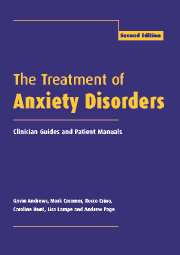Book contents
- Frontmatter
- Contents
- List of authors
- Preface to the second edition
- Abbreviations
- 1 Read me
- 2 General issues in anxiety disorders
- 3 General issues in treatment: Clinician Guide
- 4 Panic disorder and agoraphobia: Syndrome
- 5 Panic disorder and agoraphobia: Treatment
- 6 Panic disorder and agoraphobia: Clinician Guide
- 7 Panic disorder and agoraphobia: Patient Treatment Manual
- 8 Social phobia: Syndrome
- 9 Social phobia: Treatment
- 10 Social phobia: Clinician Guide
- 11 Social phobia: Patient Treatment Manual
- 12 Specific phobias: Syndrome
- 13 Specific phobias: Treatment
- 14 Specific phobias: Clinician Guide
- 15 Specific phobias: Patient Treatment Manual
- 16 Obsessive-compulsive disorder: Syndrome
- 17 Obsessive-compulsive disorder: Treatment
- 18 Obsessive-compulsive disorder: Clinician Guide
- 19 Obsessive-compulsive disorder: Patient Treatment Manual
- 20 Generalized anxiety disorder: Syndrome
- 21 Generalized anxiety disorder: Treatment
- 22 Generalized anxiety disorder: Clinician Guide
- 23 Generalized anxiety disorder: Patient Treatment Manual
- 24 Posttraumatic stress disorder: Syndrome
- 25 Posttraumatic stress disorder: Treatment
- 26 Posttraumatic stress disorder: Clinician Guide
- 27 Posttraumatic stress disorder: Patient Treatment Manual
- 28 Conclusions
- References
- Index
4 - Panic disorder and agoraphobia: Syndrome
Published online by Cambridge University Press: 05 August 2016
- Frontmatter
- Contents
- List of authors
- Preface to the second edition
- Abbreviations
- 1 Read me
- 2 General issues in anxiety disorders
- 3 General issues in treatment: Clinician Guide
- 4 Panic disorder and agoraphobia: Syndrome
- 5 Panic disorder and agoraphobia: Treatment
- 6 Panic disorder and agoraphobia: Clinician Guide
- 7 Panic disorder and agoraphobia: Patient Treatment Manual
- 8 Social phobia: Syndrome
- 9 Social phobia: Treatment
- 10 Social phobia: Clinician Guide
- 11 Social phobia: Patient Treatment Manual
- 12 Specific phobias: Syndrome
- 13 Specific phobias: Treatment
- 14 Specific phobias: Clinician Guide
- 15 Specific phobias: Patient Treatment Manual
- 16 Obsessive-compulsive disorder: Syndrome
- 17 Obsessive-compulsive disorder: Treatment
- 18 Obsessive-compulsive disorder: Clinician Guide
- 19 Obsessive-compulsive disorder: Patient Treatment Manual
- 20 Generalized anxiety disorder: Syndrome
- 21 Generalized anxiety disorder: Treatment
- 22 Generalized anxiety disorder: Clinician Guide
- 23 Generalized anxiety disorder: Patient Treatment Manual
- 24 Posttraumatic stress disorder: Syndrome
- 25 Posttraumatic stress disorder: Treatment
- 26 Posttraumatic stress disorder: Clinician Guide
- 27 Posttraumatic stress disorder: Patient Treatment Manual
- 28 Conclusions
- References
- Index
Summary
Individuals with panic disorder and agoraphobia present for treatment describing ‘panic attacks’ and varying degrees of fear-driven situational avoidance. Correspondingly, treatment aims to modify the symptoms that the person labels as ‘panic attacks’ and to reduce any avoidance. Even though the causal link between panic disorder and fearful avoidance is recognized, the major diagnostic systems draw a qualitative distinction between the panic attacks and agoraphobic avoidance.
Diagnosis
DSM-IV implies a temporal relationship between panic attacks and agoraphobic avoidance. A panic attack is characterized by: fear; feeling dizzy or faint; choking, shortness of breath, or smothering; and fears of dying, going crazy, or losing control. Primacy is given to panic disorder, which describes recurrent unexpected panic attacks or incapacitation caused by panic attacks (characterized by concern about additional attacks or worry about the consequences of future attacks). A diagnosis of panic disorder is typically given as occurring with or without agoraphobia. Agoraphobia is defined as “anxiety about being in places or situations in which escape might be difficult (or embarrassing) or in which help may not be available in the event of having an unexpected or situationally predisposed panic attack”. Situations characteristically avoided include being outside the home alone, traveling alone, being in tunnels, on bridges, and in open spaces. Agoraphobia without a history of panic attacks remains in the nosology, probably for historical reasons. In epidemiological studies, the diagnosis appears not infrequently (e.g., Robins and Regier, 1991), but such cases are rarely seen in clinical practice. fihen individual cases are examined, either they involve anxiety attacks that do not meet the particular cut-oV scores for a DSM or ICD diagnosis of a panic attack (Barlow, 1988), or they appear to be better described as a specific phobia (i.e., claustrophobia;Friend and Andrews, 1990). In contrast to DSM-IV, ICD-10 does not imply a primacy of panic attacks in its nosological structure. Agoraphobia is listed under phobic anxiety disorders and is defined behaviorally by “an interrelated and often overlapping cluster of phobias embracing fears of leaving home: fear of entering shops, crowds, and public places, or of traveling alone in trains, buses, or planes … The lack of an immediately available exit is one of the key features of many of these agoraphobic situations.”
- Type
- Chapter
- Information
- The Treatment of Anxiety DisordersClinician Guides and Patient Manuals, pp. 36 - 53Publisher: Cambridge University PressPrint publication year: 2002
- 1
- Cited by



